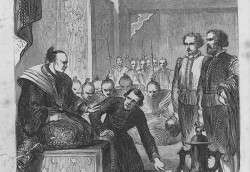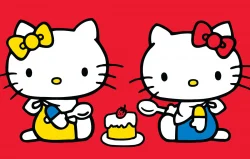
October 15, 2009
Trick or Treat?
Is there more to the controversial art of Trevor Brown than meets the eye?
By Metropolis
Originally published on metropolis.co.jp on October 2009

Nazis are Sexy, 45 x 53cm, oil on canvasboard, 2002
All images Courtesy of Trevor Brown
The thrilling thing about Halloween is the sense that the normal rules and taboos of everyday life are temporarily suspended. We can dress up as witches, zombies or ghouls; don black capes and fake fangs; walk around with makeup simulating death, disfigurement or demonic possession; and, with a sense of playfulness and irony, give vent to our deeper natures, hidden fears, secret desires and even neglected spirituality.
Having stepped out of the narrow codes of judgment and behavior that we use to circumscribe ourselves, it is also possible to approach areas of experience that we perhaps normally wouldn’t—like the work of one of the most controversial, misunderstood, yet talented artists in Japan, exiled English painter Trevor Brown.

Bondage Bear, 40 x 40cm, oil on canvas, 2005
Brown’s paintings of funny, cute, but sinister doll-like creatures, lolitas and teddy bears inhabiting a bizarre world of medical, masochistic and macabre imagery seem to emanate from a perpetual Halloween twilight zone, where innocence is inextricably enmeshed with—but never fully corrupted by—evil.
Yet even though this fascinating cocktail is an addictive passion for Brown’s fans, who religiously buy his paintings and books, it is definitely not everybody’s cup of tea. Over the years, the artist has received death threats and been accused of everything from pedophilia to Nazism, via Satanism and sadism. Reflecting the hysteria that Brown sometimes attracts, one reviewer started his article with, “Trevor Brown is a sick fuck with an Asian fetish… The toilet bowl inside this artist’s brain is overflowing with blood culled from a massive fetish orgy starring a horde of underage Japanese goth sluts for whom the more freakish, unimaginable terrain of human behavior is the norm.”

Teddy Bear Operation, size unknown, airbrush on board, 1994
“Discussion of my work always falls into opposing fractions, those who love it and those who hate it,” Brown tells Metropolis. “There’s little middle ground, unless you get someone saying they’re indifferent to it as an intended insult.”
In today’s climate of political correctness and other overactive puritanisms, it is easy to see why Brown’s art—despite its obvious saccharine charm—provokes strongly negative reactions. Perhaps his most famous series of paintings, entitled Li’l Miss Sticky Kiss (exhibited and also published in book form in 2004), shows a “loli-cosplay heroine” with a swollen black eye in a variety of costumes, including the much fetishized guises of nurse, high school girl, and SM mistress. What makes it worse for Brown’s critics is that the artist has no compunction in providing them further ammunition by emblazoning a large swastika on the SM mistress’ costume, to go with her peaked cap and concentration-camp Doberman, before provocatively entitling the piece Nazis are Sexy. The humor and the irony, quite obvious to most sensible British people, could easily be missed by others.
“My interest in the swastika is purely for its aesthetic beauty and the fact it pisses people off to a curiously disproportional extent,” Brown explains, before muddying the waters with exactly the kind of comments guaranteed to jerk yet more chains. “It’s supposed to be a good luck symbol, folks. Calm down. It’s still banned in Germany. What’s the point? Seems they—and who are ‘they’ now?—want it kept front page news forever. But it’s history now, generations old. So old that we get all these rampant revisionist theories trying to tell us the photos of piles of concentration camp corpses were done in Photoshop.”







